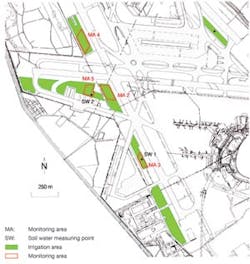Zurich Airport is Switzerland’s main airport. It has approximately 270,000 aircraft movements per year and a total area of nearly 2,000 acres of which 1,100 are green and 950 are sealed areas. The rainwater runoff from the sealed areas is 2.2 million m3 per year. In order to maintain air traffic during winter, alcohols, as well as urea in small quantities are utilized for deicing. As a consequence, the rainwater runoff is polluted with deicing chemicals.
In connection with the airport expansion between 2000 and 2004, the airport authorities arranged a competition to find an efficient method for the treatment of deicing effluents. Until then the deicer waste water was discharged untreated into the nearby river Glatt where it caused, amongst other problems, a considerable oxygen consumption.
Deicing effluents are polluted primarily with aircraft deicers and surface anti-icers. The aircraft deicers consist mainly of propylene glycol, water and some additives which are triazoles (corrosion inhibitors), tensides, food colorings and polyacrylates, which are in total less than one percent. Propylene glycol as well as tensides and the food colorings are easily bio-degradable. The polyacrilates are hardly degradable but are not environmentally hazardous whereas triazols may have a toxic potential.
Surface anti-icers consist of ethylene glycol (41%) and isopropanol (59%), urea is used in small quantities. They don’t contain additives and are easily bio-degradable. Deicer waste water may contain tarmac residues, e.g. copper (abrasion of break covering), cadmium and zinc (tire abrasion) as well as PAH (polycyclic aromatic hydrocarbons).
OBSERVATION, EVALUATION, APPLICATION
Nature at Zurich Airport was closely watched and copied. A major part of the deicing effluents are unintentionally being blown over the surrounding fields by the air traffic but nevertheless no increased impact is detected in the groundwater. It has therefore been decided to distribute the rest of the effluents onto the surrounding green areas where they are decomposed by microorganisms in a controlled, sustainable and economic way.
DISPOSAL OF DEICING EFFLUENTS
For the disposal of deicing effluents three dissolved organic carbon (DOC) concentration levels are distinguished. Less than 20 mgC/l is discharged directly into a water course, meeting the legal regulations (see Table 1). Very high concentrated effluents are used for the denitrification process in a sewage treatment plant.
Table 1NH3/
NH4+-N
To dispose of the main part of deicer waste water in between those two limits; a new, groundbreaking and cost-effective (investment and maintenance) method was developed which has been successfully applied since winter 2000–2001. The deicing effluents are irrigated onto the surrounding green areas and decomposed by microorganisms in the soil in a natural way.
The deicing effluents are collected by the sewage system in storage reservoirs where pumps feed them into the irrigation system. A total of 50 acres are equipped with heated pop-up sprinklers (see Fig. 1). The largely automated procedure is computer-controlled and supplies data for an optimum operation.
WHAT IS THE PROCESS?
The procedure, developed by Jungo Engineering Ltd., is based on field studies and theoretical approaches. The plant must be capable of coping with enormous fluctuations in concentration of deicing effluents and load, rainfall run-off and variations in temperature. The irrigation method and the biodegradation are effective even on snow and at low temperatures (–15° C air temperature.)
The main advantages of this
technique are:
• Cost-efficiency (investment
and maintenance)
• Only small size storage basins are required
• Proven on snow and at low temperatures
• Environmentally friendly and innovative, so enhancing the airport’s public image
MONITORING
Since this is the first treatment plant of this type, a group of scientists and representatives of the authorities are surveying the operation and its results during the first five years. Water, soil, vegetation and air are monitored, whereby the focus is on water, the main aim being to observe drainage and groundwater. Therefore 25 percent of the irrigated area, divided into four monitoring areas (MA, see Fig. 1), is intensively monitored. The data to control the discharging limits are collected at each monitoring area.
FINAL OUTCOME
During winter 2003–2004 only five out of 834 DOC samples exceeded the limit of 20 mgC/l, whereas the legal regulation permits that 20 percent can exceed it (see Table 1). The average DOC concentration in the drainages lay between 4.4 and 8.3 mgC/l, depending on the monitoring area. This is 1 to 3 mgC/l above the natural DOC level. The average carbon degradation performance in the single monitoring areas differed insignificantly (99.7 to 99.9 %). The average degradation performance of the previous four years lay between 98.3 and 99.8 percent (see Fig. 2).
The best degradation performance was achieved in winter 2003–2004 despite the highest C load. This was the result of continual improvement of the operation management.
The discharging limits of the N-species (ammonium, nitrite) and total phosphorus were met without exception. A wash-out due to irrigation could not be detected.
Triazoles can be found occasionally in the storage reservoirs but were not detected in the drainages of the monitoring areas. Nevertheless, efforts are made to use triazole-free deicers.
Polycyclic aromatic hydrocarbons were never detected in the storage reservoirs. Zinc, lead, cadmium and copper could be found occasionally in low concentrations. An extrapolation of the heavy metal concentrations in the soil showed that these materials do not cause a long term impact on soil fertility.
WHERE DO WE GO FROM HERE?
The past four years of experience on Zurich Airport show that the disposal of deicing effluents by irrigation is a cost-effective, sustainable and natural way to solve a waste water problem with which airports will be confronted more and more in the future. The intensive monitoring proves that a near total DOC degradation (98.3–99.8 %) is obtained.
The present level of knowledge and practical experience make it possible to design and operate such installations for other airports. To be successful the plant must be designed appropriately to answer the problem of each airport. It has to be flexible to follow the variations of nature and the enormous fluctuations of the deicer waste water input.





